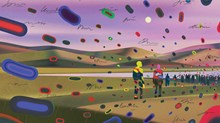In western Montana, a weed imported from France, spotted knapweed, plagues some of our best agricultural areas and is moving swiftly into wilderness areas. Only sheep will eat it. Cattle, deer, and elk won't touch it. A meadow of knapweed won't support a cow. A hillside of it will not feed elk. An infestation of knapweed can destroy a hay or grain field.
Beekeepers imported the plant for its purple blossoms that produce copious nectar even during drought years. The weed is unbelievably hardy, thriving in the driest of weather. It competes unfairly with natural flora; it grows over three feet tall so it shades shorter grasses. But if you clip it, knapweed will blossom at two inches off the ground.
Its most pernicious characteristic, however, is that knapweed is allelopathic. Knapweed's roots secrete a toxic substance that stunts and even kills the plants in its vicinity.
Toxic weeds thrive in visions for ministry, too. It is just as true of spiritual tilth as it is of good dirt: "It will produce ...
1
Support Our Work
Subscribe to CT for less than $4.25/month
























